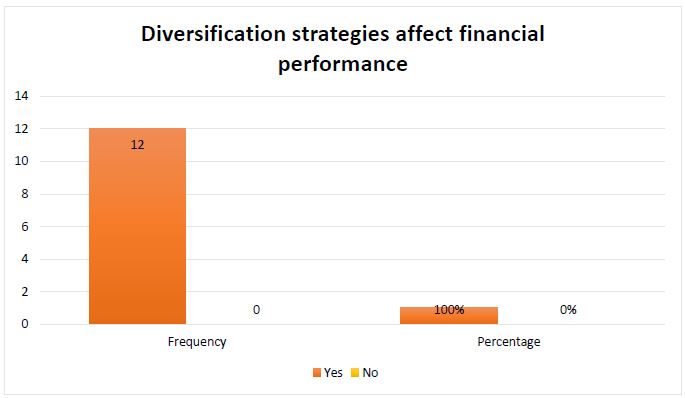Effects of Diversification Strategies on Firm’s Financial Performance: A Case Study of Zambia Postal Services Corporation
DOI:
https://doi.org/10.5281/zenodo.10889115Keywords:
diversification strategies, financial performance, postal services, zambiaAbstract
The research was devoted to discussing the effects of diversification on a firm’s financial performance a case study of Zambia Postal Services Corporation. The study was guided by 4 objectives; to identify the diversification strategies used by the Zambia postal services cooperation; to determine the effect of diversification strategies on the financial performance of the Zambia postal services cooperation, to assess the effect of the types of diversification on the financial performance of the Zambia postal services cooperation and to explore the extent to which diversification affects the financial performance of the Zambia postal services cooperation. The study used Qualitative Research Design in which 20 senior and middle Management employees of Zampost were purposively selected for interviews. The study findings established that Zambia Postal Services Corporation used concentric and horizontal diversification strategies. Diversification strategies can have either a positive or negative effect on the financial performance of the cooperation. To a greater extent, diversification affects the financial performance of the Zambia Postal Services either positively or negatively. Some of the recommendations arising from the study are that organizations willing to achieve economies of scope and redeem their financial position in the face of downturn or decline in product life cycle should diversify their product to better meet customers’ demands, profitability, expansion as well as increase performance since diversified organizations are discovered to perform better than undiversified ones; organizations should identify their rare and inimitable capabilities to achieve economies of scale and outsmart competitors and that research and Development centers should be developed for proper channeling of resources, identification of opportunities as they arise in the business environment and selection of the best strategic options.
Downloads
References
Aggarwal, R. K., & A. A. Samwick. (2003). Why do managers diversify their firms? Agency reconsidered. Journal of Finance, 58(1), 71-118.
Akewushola, R. (2015). Performance effectiveness and related product marketing diversification strategy in Nigerian companies: Information and communication technology as virile tool. Journal of Policy and Development Studies, 9(2), 211–218.
Ayeni, (2013). The effects of economic diversification on the development of tourism in Nigeria. American Journal of Tourism Management, 2(1), 15-21.
Barney, J. B. (1991). Organization resources and sustainable competitive advantage. Journal of Management, 17(1), 99-120.
Berger, P. G., & E. Ofek. (1995). Diversification's effect on firm value. Journal of Financial Economics, 37(1), 39-65.
Bettis, R. A. (1981). Performance differences in related and unrelated diversified firms. Strategic Management Journal, 2(4), 379-393.
Boston Consulting Group. (2006). How the world’s top diversified companies produce superior returns. New York: John Wiley and Sons.
Campa. J. M., & Kedia, S. (2002). Explaining the diversification discount. The Journal of Finance. http://dx.doi.org/10.1111/1540-6261.00476.
Castaldi, C., & Giarratana, M.S. (2018). Diversification strategy, branding and performance of professional service firm. Journal of Service Research, 21(3), 353–354.
Collins, D. J., & Montgomery, C. A. (2005). A corporate strategy: A resource based approach. New York: Mc Graw-Hill.
Collins, D. J., & Montgomery, C. A. (2008). A corporate strategy: A resource based approach. (2nd ed.). New York: Mc Graw-Hill.
Gary, S. (2005). Implementation strategy and performance outcomes in related diversification. Strategic Management Journal, 3(4), 100-112.
Hashai, N. (2015). Within industry diversification and firm performance- An S–shaped hypothesis. Strategic Management Journal, 36(9), 1378–1400.
Hoechle, D., Schmid, M., Walter, I., & Yermarck, D. (2009). How much of the diversification discount can be explained by poor corporate governance?. http://dx.doi.org/10.2139/ssrn.1341006.
Ivan, P., & Maja, P. (2010). Effects of corporate diversification onits performance: the case of Croatian non-life insurance industry. Ekon. Misao I Praksa Dbk. God, 19(1), 49-66.
Ilukena M, Haabazoka L, & Chowa T. (2023). Environmental factors moderating effect on intangible organisational resources and performance of insurance brokers in Zambia. In: Popkova RG(eds) Smart Green Innovations in Industry 4.0.

Downloads
Published
How to Cite
Issue
Section
ARK
License
Copyright (c) 2024 Michelo Chiimo Mweemba, Dr. Bupe Getrude Mwanza

This work is licensed under a Creative Commons Attribution 4.0 International License.
Research Articles in 'Social Science Journal for Advanced Research' are Open Access articles published under the Creative Commons CC BY License Creative Commons Attribution 4.0 International License http://creativecommons.org/licenses/by/4.0/. This license allows you to share – copy and redistribute the material in any medium or format. Adapt – remix, transform, and build upon the material for any purpose, even commercially.










